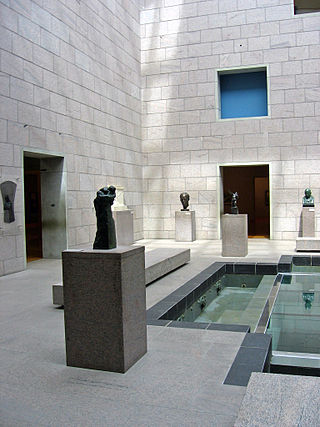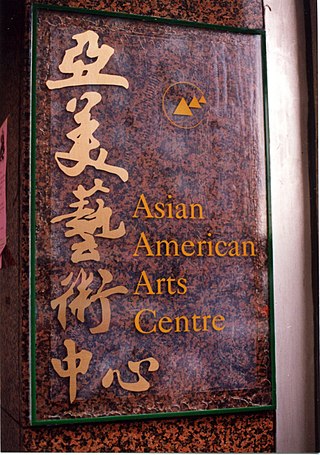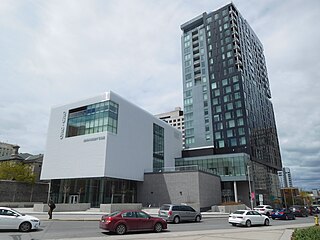Related Research Articles
Public art is art in any media whose form, function and meaning are created for the general public through a public process. It is a specific art genre with its own professional and critical discourse. Public art is visually and physically accessible to the public; it is installed in public space in both outdoor and indoor settings. Public art seeks to embody public or universal concepts rather than commercial, partisan, or personal concepts or interests. Notably, public art is also the direct or indirect product of a public process of creation, procurement, and/or maintenance.
The Ontario Arts Council (OAC) is a publicly-funded Canadian organization in the province of Ontario whose purpose is to foster the creation and production of art for the benefit of all Ontarians. Based in Toronto, OAC was founded in 1963 by Ontario's Premier at the time, John Robarts.
Artist-in-residence, or artist residencies, encompass a wide spectrum of artistic programs which involve a collaboration between artists and hosting organisations, institutions, or communities. They are programs which provide artists with space and resources to support their artistic practice. Contemporary artist residencies are becoming increasingly thematic, with artists working together with their host in pursuit of a specific outcome related to a particular theme.
Community art, also known as social art, community-engaged art, community-based art, and, rarely, dialogical art, is the practice of art based in and generated in a community setting. It is closely related to social practice and social turn. Works in this form can be of any media and are characterized by interaction or dialogue with the community. Professional artists may collaborate with communities which may not normally engage in the arts. The term was defined in the late 1960s as the practice grew in the United States, Canada, the Netherlands, the United Kingdom, Ireland, and Australia. In Scandinavia, the term "community art" more often refers to contemporary art projects.

An artist-run space or artist-run centre (Canada) is a gallery or other facility operated or directed by artists, frequently circumventing the structures of public art centers, museums, or commercial galleries and allowing for a more experimental program. An artist-run initiative (ARI) is any project run by artists, including sound or visual artists, to present their and others' projects. They might approximate a traditional art gallery space in appearance or function, or they may take a markedly different approach, limited only by the artist's understanding of the term. "Artist-run initiatives" is an umbrella name for many types of artist-generated activity.

Cultural policy is the government actions, laws and programs that regulate, protect, encourage and financially support activities related to the arts and creative sectors, such as painting, sculpture, music, dance, literature, and filmmaking, among others and culture, which may involve activities related to language, heritage and diversity. The idea of cultural policy was developed at UNESCO in the 1960s. Generally, this involves governments setting in place processes, legal classifications, regulations, legislation and institutions which promote and facilitate cultural diversity and creative expressions in a range of art forms and creative activities. Cultural policies vary from one country to another, but generally they aim to improve the accessibility of arts and creative activities to citizens and promote the artistic, musical, ethnic, sociolinguistic, literary and other expressions of all people in a country. In some countries, especially since the 1970s, there is an emphasis on supporting the culture of Indigenous peoples and marginalized communities and ensuring that cultural industries are representative of a country's diverse cultural heritage and ethnic and linguistic demographics.
Arts administration is a field in the arts sector that facilitates programming within cultural organizations. Arts administrators are responsible for facilitating the day-to-day operations of the organization as well as the long term goals by and fulfilling its vision, mission and mandate. Arts management became present in the arts and culture sector in the 1960s. Organizations include professional non-profit entities. For examples theaters, museums, symphony orchestras, concert bands, jazz organizations, opera houses, ballet companies and many smaller professional and non-professional for-profit arts-related organizations. The duties of an arts administrator can include staff management, marketing, budget management, public relations, fundraising, program development evaluation, community engagement, strategic planning, and board relations.
The term percent for art refers to a program, often a city ordinance, where a fee, usually some percentage of the project cost, is placed on large scale development projects in order to fund and install public art. The details of such programs vary from area to area. Percent for art programs are used to fund public art where private or specialized funding of public art is unavailable. Similar programs, such as "art in public places", attempt to achieve similar goals by requiring that public art be part of a project, yet they often allow developers to pay in-lieu fees to a public art fund as an alternative.

The Fairfield Industrial Dog Object (FIDO) is a huge sculpture in hardwood of a canine in the inner northern Melbourne suburb of Fairfield, Victoria, Australia. It was part of the Darebin City Council's Public Art Program, and is located beside the Fairfield railway station.

Education in Victoria, Australia is supervised by the Department of Education and Training (DET), which is part of the State Government and whose role is to "provide policy and planning advice for the delivery of education". It acts as advisor to two state ministers, that for Education and for Children and Early Childhood Development.

The Asian American Arts Centre (AAAC) is a non-profit organization located in the Chinatown neighborhood of Manhattan in New York City. Founded in 1974, it's one of the earliest Asian American community organizations in the United States. The Arts Centre presents the ongoing developments between contemporary Asian & Asian American art forms and Western art forms through the presentation of performance, exhibitions, and public education. AAAC's permanent collection, which it has accumulated since 1989, contains hundreds of contemporary Asian American art works and traditional/folk art pieces. The organization also has an Artists Archive which documents, preserves, and promotes the presence of Asian American visual culture in the United States since 1945. This includes the East Coast, especially the greater New York area; the West Coast; and some artists in Canada, Hawaii, and overseas. The artists include Asian Americans producing art, Asian artists who are active in the United States, and other Americans who are significantly influenced by Asia. Pan-Asian in outlook, the Arts Centre's understanding of 'Asia' encompasses traditions and influences with sources ranging from Afghanistan to Hawaii.

The Treasury Section of Painting and Sculpture was a New Deal art project established on October 16, 1934, and administered by the Procurement Division of the United States Department of the Treasury.

Norman Henry Lacy is an Australian former politician, who was a Victorian Government Minister from May 1979 to April 1982.

Arts on the Line was a program devised to bring art into the Massachusetts Bay Transportation Authority (MBTA) subway stations in the late 1970s and early 1980s. Arts on the Line was the first program of its kind in the United States and became the model for similar drives for art across the country. The first twenty artworks were completed in 1985 with a total cost of US$695,000, or one half of one percent of the total construction cost of the Red Line Northwest Extension, of which they were a part.

The Victorian College of the Arts (VCA) is the arts school at the University of Melbourne in Australia. It is part of the university's Faculty of Fine Arts and Music (FFAM). It is located near the Melbourne city centre on the Southbank campus of the university.

The Boston Art Commission, established in 1890, exercises legal authority to approve and site new public art on property owned by the City of Boston. Woven through the urban landscape, site-specific artworks identify Boston as a place with long history and a great capacity for innovation. These artworks, both permanent and temporary, range from traditional and new media public art pieces to municipal design elements, such as wayfinding systems and artistic lighting. In addition, the Art Commission has care and custody of all paintings, murals, statues, bas-reliefs, sculptures, monuments, fountains, arches and other permanent structures intended for ornament or commemoration on City property. It is the conviction of the Boston Art Commission that, in order to engender and support a thriving artistic consciousness within the city, community involvement shall extend beyond everyday appreciation to meaningful engagement in the creation, evolving interpretation and ongoing care of artworks throughout Boston's neighborhoods.
The South East Centre for Contemporary Art (SECCA) formerly known as Bega Valley Regional Gallery is a publicly funded art gallery and cultural facility located in the town centre of Bega in south eastern New South Wales, Australia. The gallery showcases contemporary Australian visual culture with up to ten exhibitions annually. In 2016 the gallery expanded its footprint as the cultural outpost on Australia’s Coastal Wilderness and launched two project spaces, one at the Merimbula Airport and one at the Port of Eden Welcome Centre.

Arts Project Australia Inc. is a registered charity and non-profit organisation located in Northcote, an inner northern area of Melbourne, Victoria, Australia. The organisation provides facilitation/mentoring, studio and exhibition spaces for artists with intellectual disabilities, and as such has been identified as a major centre for the promotion and exhibition of outsider art, or art that has been produced outside of the contemporary and historical mainstream. In 2016 there were approximately 130 artists attending the studio, with the work of exhibiting artists featuring alongside works from the broader contemporary art community in the annual rotating exhibition program.

The Ottawa Art Gallery (OAG) is a municipal gallery in Ottawa, Ontario that opened in 1988 at Arts Court. The gallery has a permanent collection of over one thousand works, houses the City of Ottawa-owned Firestone Collection of Canadian Art, and provides community, educational and public programming. The OAG focuses on acquiring, interpreting, and sharing art as well as acting as a cultural meeting place.
Liquid Architecture is an Australian non-profit art organisation with a focus on experimental music, sonic art, contemporary performance, pedagogy and discourse based in Naarm/Melbourne.
References
- ↑ Beardsley, John. 1980. "Art in Public Places: A Survey of Community-Sponsored Projects Supported by the National Endowment for the Arts,"
- ↑ Project for Public Spaces. Dec. 31, 2008, "Funding Sources for Public Art"